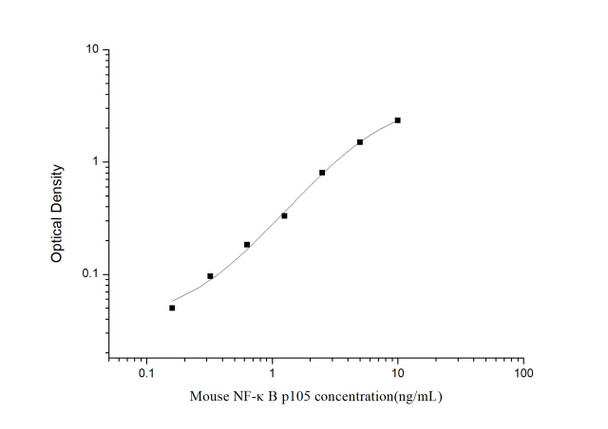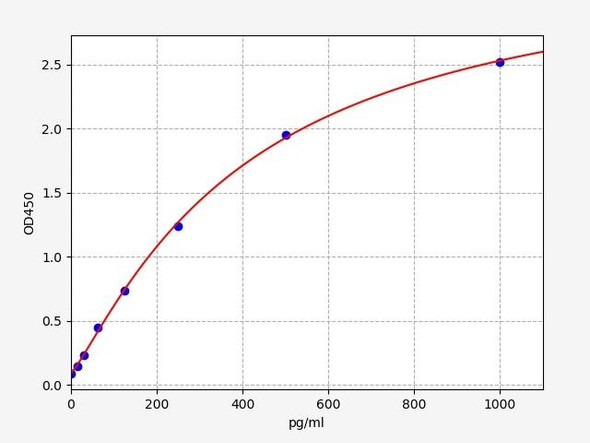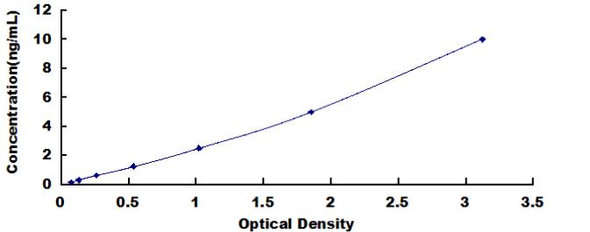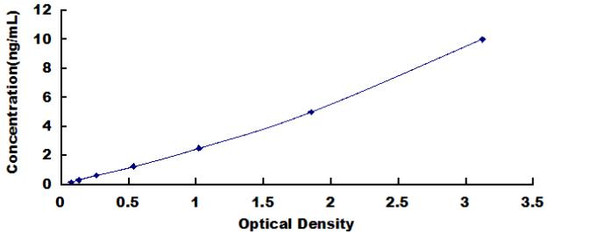Mouse Cell Death ELISA Kits
Mouse NFkB (Nuclear Factor Kappa B) ELISA Kit (MOES01303)
- SKU:
- MOES01303
- Product Type:
- ELISA Kit
- Size:
- 96 Assays
- Uniprot:
- P25799
- Sensitivity:
- 0.09ng/mL
- Range:
- 0.16-10ng/mL
- ELISA Type:
- Sandwich
- Synonyms:
- NFKB1, NF-KB1, NF-Kappa-B, NFKB-p105, NFKB-p50, p105, p50, EBP-1, KBF1
- Reactivity:
- Mouse
- Sample Type:
- Serum, plasma and other biological fluids
- Research Area:
- Cell Death
Description
| Assay type: | Sandwich |
| Format: | 96T |
| Assay time: | 4.5h |
| Reactivity: | Mouse |
| Detection Method: | Colormetric |
| Detection Range: | 0.16-10 ng/mL |
| Sensitivity: | 0.10 ng/mL |
| Sample Volume Required Per Well: | 100µL |
| Sample Type: | Serum, plasma and other biological fluids |
| Specificity: | This kit recognizes Mouse NFkB in samples. No significant cross-reactivity or interference between Mouse NFkB and analogues was observed. |
This ELISA kit uses Sandwich-ELISA as the method. The micro ELISA plate provided in this kit has been pre-coated with an antibody specific to Mouse NFkB. Standards or samples are added to the appropriate micro ELISA plate wells and combined with the specific antibody. Then a biotinylated detection antibody specific for Mouse NFkB and Avidin-Horseradish Peroxidase (HRP) conjugate are added to each micro plate well successively and incubated. Free components are washed away. The substrate solution is added to each well. Only those wells that contain Mouse NFkB, biotinylated detection antibody and Avidin-HRP conjugate will appear blue in color. The enzyme-substrate reaction is terminated by adding Stop Solution and the color turns yellow. The optical density (OD) is measured spectrophotometrically at a wavelength of 450 nm ± 2 nm. The OD value is proportional to the concentration of Mouse NFkB. The concentration of Mouse NFkB in samples can be calculated by comparing the OD of the samples to the standard curve.
| UniProt Protein Function: | NFkB-p105: a transcription factor of the nuclear factor-kappaB ( NFkB) group. Undergoes cotranslational processing by the 26S proteasome to produce a 50 kD protein. The 105 kD protein is a Rel protein-specific transcription inhibitor and the 50 kD protein is a DNA binding subunit of NFkB. NFkB is a transcription regulator that is activated by various intra- and extra-cellular stimuli such as cytokines, oxidant-free radicals, ultraviolet irradiation, and bacterial or viral products. Activated NFkB translocates into the nucleus and stimulates the expression of genes involved in a wide variety of biological functions. Inappropriate activation of NFkB has been associated with a number of inflammatory diseases while persistent inhibition of NFkB leads to inappropriate immune cell development or delayed cell growth. There are five NFkB proteins in mammals (RelA/NFkB-p65, RelB, c-Rel, NF-_B1/NFkB-p105, and NF-_B2/NFkB-p100). They form a variety of homodimers and heterodimers, each of which activates its own characteristic set of genes. Two alternatively spliced isoforms have been described. |
| UniProt Protein Details: | Protein type:DNA-binding; Transcription factor Cellular Component: nucleoplasm; protein complex; mitochondrion; cytoplasm; nucleus; cytosol Molecular Function:protein binding; protein homodimerization activity; DNA binding; protein heterodimerization activity; sequence-specific DNA binding; heat shock protein binding; double-stranded DNA binding; chromatin binding; transcription factor activity Biological Process: transcription from RNA polymerase II promoter; I-kappaB kinase/NF-kappaB cascade; transcription, DNA-dependent; apoptosis; positive regulation of transcription, DNA-dependent; cellular response to stress; negative regulation of interleukin-12 biosynthetic process; negative regulation of transcription from RNA polymerase II promoter; signal transduction; lymph node development; regulation of transcription, DNA-dependent; response to cytokine stimulus; negative regulation of inflammatory response; negative regulation of cytokine production; innate immune response; positive regulation of transcription from RNA polymerase II promoter; response to oxidative stress; negative regulation of transcription, DNA-dependent; negative regulation of apoptosis |
| UniProt Code: | P25799 |
| NCBI GenInfo Identifier: | 341941170 |
| NCBI Gene ID: | 18033 |
| NCBI Accession: | P25799. 2 |
| UniProt Related Accession: | P25799 |
| Molecular Weight: | |
| NCBI Full Name: | Nuclear factor NF-kappa-B p105 subunit |
| NCBI Synonym Full Names: | nuclear factor of kappa light polypeptide gene enhancer in B cells 1, p105 |
| NCBI Official Symbol: | Nfkb1 |
| NCBI Official Synonym Symbols: | p50; p105; NF-KB1; p50/p105; NF-kappaB; NF-kappaB1 |
| NCBI Protein Information: | nuclear factor NF-kappa-B p105 subunit |
| UniProt Protein Name: | Nuclear factor NF-kappa-B p105 subunit |
| UniProt Synonym Protein Names: | DNA-binding factor KBF1; EBP-1; NF-kappa-B1 p84/NF-kappa-B1 p98; Nuclear factor of kappa light polypeptide gene enhancer in B-cells 1Cleaved into the following chain:Nuclear factor NF-kappa-B p50 subunit |
| UniProt Gene Name: | Nfkb1 |
| UniProt Entry Name: | NFKB1_MOUSE |
As the OD values of the standard curve may vary according to the conditions of the actual assay performance (e. g. operator, pipetting technique, washing technique or temperature effects), the operator should establish a standard curve for each test. Typical standard curve and data is provided below for reference only.
| Concentration (ng/mL) | O.D | Average | Corrected |
| 10 | 2.382 2.44 | 2.411 | 2.343 |
| 5 | 1.567 1.569 | 1.568 | 1.5 |
| 2.5 | 0.873 0.871 | 0.872 | 0.804 |
| 1.25 | 0.386 0.412 | 0.399 | 0.331 |
| 0.63 | 0.262 0.24 | 0.251 | 0.183 |
| 0.32 | 0.176 0.152 | 0.164 | 0.096 |
| 0.16 | 0.112 0.124 | 0.118 | 0.05 |
| 0 | 0.061 0.075 | 0.068 | -- |
Precision
Intra-assay Precision (Precision within an assay): 3 samples with low, mid range and high level Mouse NFkB were tested 20 times on one plate, respectively.
Inter-assay Precision (Precision between assays): 3 samples with low, mid range and high level Mouse NFkB were tested on 3 different plates, 20 replicates in each plate.
| Intra-assay Precision | Inter-assay Precision | |||||
| Sample | 1 | 2 | 3 | 1 | 2 | 3 |
| n | 20 | 20 | 20 | 20 | 20 | 20 |
| Mean (ng/mL) | 0.51 | 1.25 | 4.08 | 0.48 | 1.13 | 4.17 |
| Standard deviation | 0.03 | 0.05 | 0.13 | 0.03 | 0.06 | 0.22 |
| C V (%) | 5.88 | 4.00 | 3.19 | 6.25 | 5.31 | 5.28 |
Recovery
The recovery of Mouse NFkB spiked at three different levels in samples throughout the range of the assay was evaluated in various matrices.
| Sample Type | Range (%) | Average Recovery (%) |
| Serum (n=5) | 86-101 | 92 |
| EDTA plasma (n=5) | 93-108 | 100 |
| Cell culture media (n=5) | 86-101 | 93 |
Linearity
Samples were spiked with high concentrations of Mouse NFkB and diluted with Reference Standard & Sample Diluent to produce samples with values within the range of the assay.
| Serum (n=5) | EDTA plasma (n=5) | Cell culture media (n=5) | ||
| 1:2 | Range (%) | 92-104 | 95-113 | 88-103 |
| Average (%) | 97 | 103 | 94 | |
| 1:4 | Range (%) | 93-104 | 84-95 | 88-102 |
| Average (%) | 99 | 89 | 93 | |
| 1:8 | Range (%) | 87-102 | 85-96 | 86-97 |
| Average (%) | 93 | 91 | 92 | |
| 1:16 | Range (%) | 88-100 | 86-98 | 81-95 |
| Average (%) | 93 | 92 | 87 |
An unopened kit can be stored at 4°C for 1 month. If the kit is not used within 1 month, store the items separately according to the following conditions once the kit is received.
| Item | Specifications | Storage |
| Micro ELISA Plate(Dismountable) | 8 wells ×12 strips | -20°C, 6 months |
| Reference Standard | 2 vials | |
| Concentrated Biotinylated Detection Ab (100×) | 1 vial, 120 µL | |
| Concentrated HRP Conjugate (100×) | 1 vial, 120 µL | -20°C(shading light), 6 months |
| Reference Standard & Sample Diluent | 1 vial, 20 mL | 4°C, 6 months |
| Biotinylated Detection Ab Diluent | 1 vial, 14 mL | |
| HRP Conjugate Diluent | 1 vial, 14 mL | |
| Concentrated Wash Buffer (25×) | 1 vial, 30 mL | |
| Substrate Reagent | 1 vial, 10 mL | 4°C(shading light) |
| Stop Solution | 1 vial, 10 mL | 4°C |
| Plate Sealer | 5 pieces | |
| Product Description | 1 copy | |
| Certificate of Analysis | 1 copy |
- Set standard, test sample and control (zero) wells on the pre-coated plate and record theirpositions. It is recommended to measure each standard and sample in duplicate. Note: addall solutions to the bottom of the plate wells while avoiding contact with the well walls. Ensuresolutions do not foam when adding to the wells.
- Aliquot 100µl of standard solutions into the standard wells.
- Add 100µl of Sample / Standard dilution buffer into the control (zero) well.
- Add 100µl of properly diluted sample (serum, plasma, tissue homogenates and otherbiological fluids) into test sample wells.
- Cover the plate with the sealer provided in the kit and incubate for 90 min at 37°C.
- Aspirate the liquid from each well, do not wash. Immediately add 100µL of BiotinylatedDetection Ab working solution to each well. Cover the plate with a plate seal and gently mix. Incubate for 1 hour at 37°C.
- Aspirate or decant the solution from the plate and add 350µL of wash buffer to each welland incubate for 1-2 minutes at room temperature. Aspirate the solution from each well andclap the plate on absorbent filter paper to dry. Repeat this process 3 times. Note: a microplatewasher can be used in this step and other wash steps.
- Add 100µL of HRP Conjugate working solution to each well. Cover with a plate seal andincubate for 30 min at 37°C.
- Aspirate or decant the solution from each well. Repeat the wash process for five times asconducted in step 7.
- Add 90µL of Substrate Reagent to each well. Cover with a new plate seal and incubate forapproximately 15 min at 37°C. Protect the plate from light. Note: the reaction time can beshortened or extended according to the actual color change, but not by more than 30min.
- Add 50 µL of Stop Solution to each well. Note: Adding the stop solution should be done inthe same order as the substrate solution.
- Determine the optical density (OD value) of each well immediately with a microplate readerset at 450 nm.






